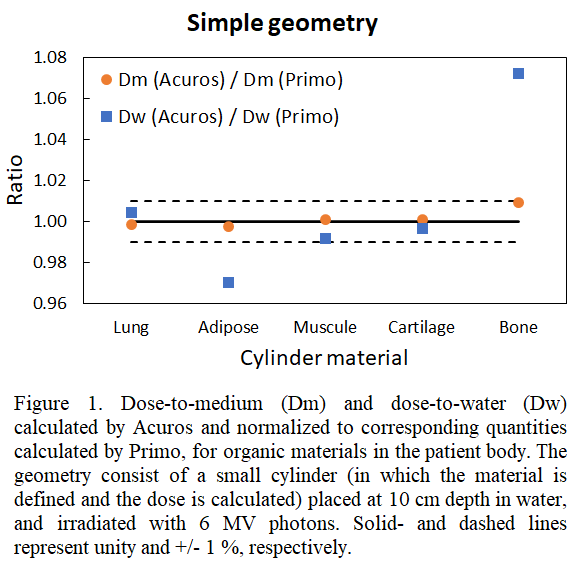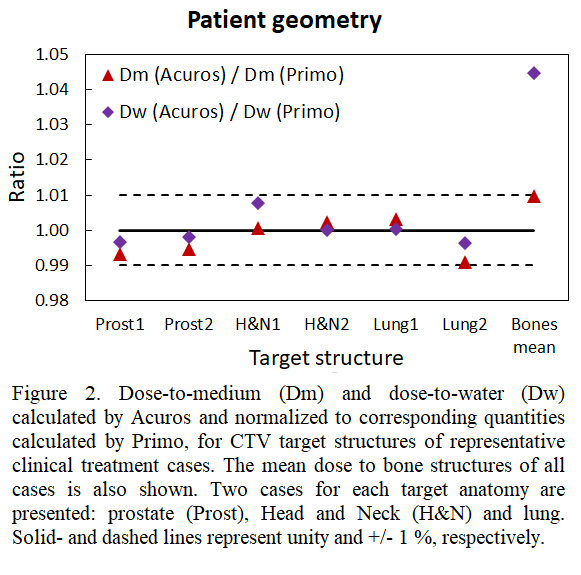Dose-to-medium and dose-to-water in photon radiotherapy dose calculations
PO-1819
Abstract
Dose-to-medium and dose-to-water in photon radiotherapy dose calculations
Authors: Mohammed Ghazal1,2, Hamza Benmakhlouf1,2
1Karolinska University Hospital, Department of Medical Radiation Physics and Nuclear Medicine, Stockholm, Sweden; 2Karolinska Institute, Department of Oncology-Pathology, Stockholm, Sweden
Show Affiliations
Hide Affiliations
Purpose or Objective
Modern TPSs implement dose calculation algorithms where the user can select the reported dose as dose-to-medium (Dm) or dose-to-water (Dw). Regardless of which quantity is chosen, these algorithms calculate the fluence in the patient by segmenting the CT-images into different tissue types, taking into account differences in interaction properties. Thus, Dm is always calculated and if Dw is selected, a conversion is applied. This work aims at quantifying the accuracy of Acuros in determining Dm and Dw in simple- and patient geometries.
Material and Methods
The simple geometry consisted of a small cylinder of different materials placed in a water phantom. Secondly, representative clinical treatment plans were selected: H&N, lung and prostate cases (two plans per target anatomy). PRIMO, a full-scale Monte Carlo-based system, was used to model a 6 MV beam similar to that of Acuros. Dm and Dw were calculated in the cylinder and the CTVs of each plan using PRIMO and Acuros.
Results
Figure 1 shows the cylinder Dm and Dw, calculated by Acuros and normalized to corresponding PRIMO-calculated doses, for a number of organic materials. Using PRIMO as a reference, Dm calculated by Acuros are within 0.1% for lung, adipose, muscle and cartilage whereas it deviates by 1% for bone. This may be attributed to bone having a higher mass density and/or significantly different atomic composition. Dw in Acuros for lung, muscle and cartilage is accurately converted from Dm with an average deviation of 0.5% compared to PRIMO-calculated doses. However, Dw in adipose and bone show a 3% and 7% discrepancy, respectively. This might be due to Acuros converting Dm to Dw using electron energy deposition cross section ratios which assumes that the fluences are identical in water and medium. It has been shown by others that a fluence correction is needed for bone and adipose due to significant difference in their I-value compared to that of water. Figure 2 shows Dm and Dw calculated by Acuros normalized to PRIMO, for CTV targets in H&N, prostate and lung clinical cases. All CTV doses from Acuros are within 1%. This is due to CTVs consist mostly of muscle tissue in prostate- and H&N cases, and lung- and muscle tissues in lung cases. The average dose discrepancy for bone structures of all cases is also seen in Figure 2 where Dm and Dw deviate by 1% and 5%, respectively. These results agree with those of the simple geometry.


Conclusion
Acuros calculates Dm with high accuracy where the largest deviation from PRIMO is 1% for bone tissue. Furthermore, Dm is accurately converted to Dw by Acuros for all tissue types except for bone tissue where simple- and patient geometry show 7% and 5% discrepancy, respectively. Conversion to Dw for adipose was shown to deviate 3% in the simple geometry. Implementing Acuros in clinical practice is encouraged but caution is advised regarding Dw in adipose and bone tissue (e.g., abdominal superficial- and pelvic/spinal SBRT targets).